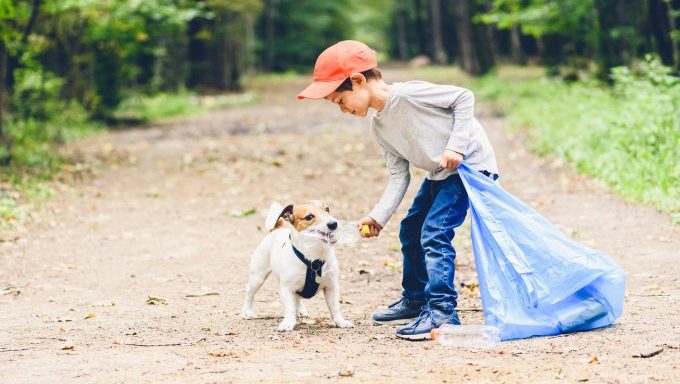
If you thought only humans wreaked havoc on the planet, think again. Dogs also have a carbon footprint (also known as a carbon pawprint). As Earth Day approaches, going green is on everyone’s minds. You know eco-friendly practices are essential for humans to embrace, but have you considered how your four-legged BFF can also protect the planet?
How big is the canine carbon pawprint?
One study examined the impact pets have on the planet — and the news was not good. Our pets eat a lot, and feeding them results in about 64 million tons of carbon dioxide in the U.S. annually. That’s the environmental equivalent of 13.6 million cars polluting the air. But wait! It gets worse. If pets formed their own country (hey, it could happen), it would be fifth in line for global meat consumption. (China, the U.S., Brazil, and Russia are the only countries that would top it.) So says Gregory Okin, UCLA professor and author of the aforementioned study.
How to reduce your dog’s carbon pawprint
As pet owners, we want to give our furry friends the best life possible. However, being a responsible pet owner also means taking steps to reduce our pets’ impact on the environment. Here are five easy ways to reduce your dog’s carbon pawprint.
Switch to plant-based food
The production and transportation of animal-based dog food have a significant environmental impact. Switching to plant-based dog food can reduce your dog’s carbon footprint while providing your pup with essential nutrients. Look for dog food and treats made with sustainable ingredients such as chickpeas, lentils, and quinoa. Insect-based dog foods are another excellent alternative gaining popularity in the market. Some dogs may need time to adjust to the new diet, so gradually introduce plant-based food into their meals.
Dispose of dog waste mindfully
Dog waste can be a significant source of water pollution and a threat to public health. According to the Environmental Protection Agency, the average pup produces 274 pounds of poop annually! And as a dog owner, it’s your “doody” to pick it up!
Even if the poop is in your own backyard, it’s still in your best interest to scoop and bag it ASAP. Why? Because dog waste can contain pathogens, parasites, and bacteria that can lead to human illness. Even when the poop appears to have dissipated or been washed away, microorganisms like Giardia, E. coli, and Roundworms can survive up to four years in your yard! Don’t let that poop pile up!
Fecal runoff is another environmental issue caused by abandoned dog poop. It happens when rain washes poop (and its accompanying parasites) into the water system. One study found that 20 – 30% of the total bacteria in watersheds directly resulted from dog poop. Eww.
So you’re going to pick up that poop every time, right? Great! Just don’t use a plastic bag. According to the Animal Humane Society, plastic dog waste bags take 10 to 1,000 years to break down in landfills. Switch to biodegradable bags instead and throw them in the trash. Consider using an eco-friendly dog poop bag made from renewable resources and free of harmful chemicals, like this one from Amazon.
Use Clean Grooming Products
Many dog grooming products contain chemicals that can harm your dog and the environment. Choose clean, natural grooming products free of parabens, sulfates, and synthetic fragrances. Look for products that use organic ingredients and biodegradable packaging. Worried that this will get expensive or that you’ll have to make an extra trip to scope out these products? Nah. Petco has a new clean grooming initiative so you can pick up natural grooming products on your regular pet supplies shopping trip. Your dog’s coat and the environment will thank you!
Choose eco-friendly dog products
From toys to collars, there are many eco-friendly dog products available. These products are made from sustainable materials and are designed to minimize environmental impact. Look for toys made from recycled materials. Choose collars made from hemp or bamboo. Get a dog bed made from organic cotton. Swap plastic dog bowls for stainless steel or ceramic ones. Choosing eco-friendly products reduces your dog’s carbon footprint while supporting sustainable manufacturing. When you’re done with your pet products, upcycle or swap them with other dog owners. Facebook is an awesome place to do this!
Adopt responsibly
Adopting a dog from a shelter or rescue is another way to reduce your dog’s carbon footprint. Adopting a pet reduces the demand for breeding and helps reduce the number of animals in shelters. By adopting a dog, you’re providing them with a loving home and reducing their environmental impact.
We aren’t sizeists or ableists here at DogTime, but experts say that adopting a small dog and/or one without health issues can also reduce your pup’s carbon pawprint. That’s because small dogs eat less and healthy canines require fewer veterinary interventions.
Research any breed before adopting to ensure the dog’s needs match your lifestyle. And always sterilize your pet to help control the pet population!
Go green
Reducing your dog’s carbon footprint doesn’t have to be complicated. By switching to plant-based food, disposing of dog waste mindfully, using clean grooming products, choosing eco-friendly dog products, and adopting responsibly, you can positively impact the environment. Start small and make changes where you can. Together, we can make a difference for our furry friends and the planet!
ChatGPT assisted in the creation of this article.




